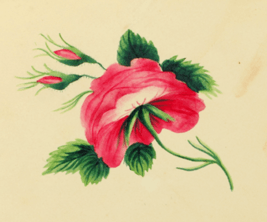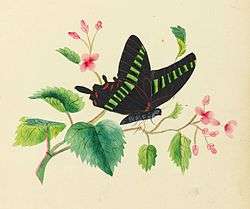Sarah Mapps Douglass

Sarah Mapps Douglass (September 9, 1806 – September 8, 1882) was an African American educator, abolitionist, writer, and public lecturer. Her painted images on her written letters may be the first or earliest surviving examples of signed paintings by an African-American woman. These paintings are contained within the Cassey Dickerson Album. The album is a rare collection of 19th century friendship letters between a group of women.[1]
Life and career
Sarah Mapps Douglass was born in Philadelphia, Pennsylvania, to a prominent abolitionist family, the only daughter of Robert Douglass, a hairdresser, and Grace Bustill Douglass, a milliner and teacher. Sarah's grandfather, Cyrus Bustill, a Quaker who owned a bakery, operated a school run from his home, was one of the early members of the Free African Society, an early African American charity organization. Sarah grew up among Philadelphia's elite, and according to C. Peter Ripley "[s]he received extensive [private] tutoring as a child."[2]
In 1825, Sarah began teaching in Philadelphia at a school organized by her mother with James Forten, the wealthy African American sailmaker.[3] Starting in 1833, she taught briefly at the Free African School for Girls, before establishing her own school for African American girls. She was soon recognized as a talented teacher, of the sciences and arts, at which she herself excelled, and for holding her students to high standards. In 1838, the Philadelphia Female Anti-Slavery Society took over the school, retaining Sarah as the headmaster. In 1854, the school merged with the Institute for Colored Youth – now Cheyney State University – on Lombard Street, and Sarah become the head of the primary department, a position she held until her retirement in 1877.
Sarah’s role as an activist began as early as 1831, when at twenty-five, she organized the collection of money to send to William Lloyd Garrison to support the The Liberator. Sarah also helped with the creation of the Female Literary Society, a group of African American women dedicated to improving their skills and deepening their identification with slave sisters.[4]

Black literacy societies began forming in urban Northern cities in the late 1820s and early 1830s. These societies turned to reading as an invaluable method of acquiring knowledge and to writing as a means of asserting identity, recording information, and communicating with a black public that ranged from the literate to the semi-literate to the illiterate.[5] Societies were based on the idea that for the welfare and survival of the community, individuals had to come together in larger groups that would both create a sense of national identity and collective spirit and would extend essential knowledge to the black community, both free and enslaved.[6]
The Female Literary Society encouraged self-improvement through education for both the literate and illiterate and to both the free and enslaved. Education was to challenge white beliefs in the intellectual inferiority of African Americans. Sarah and the women of the Society believed that the "cultivation of intellectual powers" was the greatest human pursuit, because God had bestowed those powers and talents.[7] It was their duty as women and African Americans to use those talents to try to break down the existing divides between African Americans and Whites, and to fight for equal rights to advance their race.
The members of the Female Literacy Society met every Tuesday with meetings devoted to reading and recitation for the purpose of "mutual improvement in moral and literacy pursuits."[8] According to their supporter William Lloyd Garrison, nearly all of the members would weekly write original pieces, put anonymously into a box, that a committee afterwards criticized.[8] Sarah herself often wrote prose and poetry, much of it published in "Ladies’ Department" of The Liberator, The Colored American, and the Anglo-African Magazine under the pseudonym Zillah and possibly also "Sophonisba."[9]
In an address to the Association in 1832 at a "mental feast," Sarah shared how the call to activism with the Female Literary Association came about:
"One short year ago, how different were my feelings on the subject of slavery! It is true, the wail of the captive sometimes came to my ear in the midst of my happiness, and caused my heart to bleed for his wrongs; but, alas! the impression was as evanescent as the early cloud and morning dew. I had formed a little world of my own, and cared not to move beyond its precincts. But how was the scene changed when I held the oppressor lurking on the border of my peaceful home! I saw his iron hand stretched forth to seize me as his prey, and the cause of the slave became my own. I started up, and with one mighty effort threw from me the lethargy which had covered me as a mantle for years; and determined, by the help of the Almighty, to use every exertion in my power to elevate the character of my wronged and neglected race."
With her mother, she was a founding member (1833) of the bi-racial Philadelphia Female Anti-Slavery Society. The Society, from the beginning, was interracial, including members of African American descent like Sarah along with white women members, like Lucretia Mott. The purpose of the society was to secure the total abolition of slavery as soon as possible, without any compensation to the slaveholders as well as to procure equal civil and religious rights with the white people of the United States.[10]
On December 14, 1833, the society finalized their Constitution, which stated that they deemed it their duty "as professing Christians to manifest [their] abhorrence of the flagrant injustice and deep sin of slavery by united and vigorous exertions."[11] Membership in the society was open to any woman who subscribed to these views and contributed to the Society.
The members of the Society subscribed to several antislavery journals such as Garrison’s The Liberator and The Emancipator to circulate among the members and their friends. The Society also accumulated a small library of antislavery books and pamphlets for dissemination. "Within its first year, it also established a school for African American children. The Society also promoted the boycott of goods manufactured by slaves and lobbied for emancipation. This included circulating petitions to Congress for the abolition of slavery in the District of Columbia and other federal territories and for suppressing the slave trade between the American states."[12] By 1840, Sarah had served in the group as a member of the board of directors, of the committee on annual fairs, of the education committee, recording and corresponding secretary, librarian, and manager.
From 1853 to 1877, Sarah studied anatomy, female health and hygiene, and acquired medical basic training at the Female Medical College of Pennsylvania – becoming the first African American female student – and at the Ladies' Institute of Pennsylvania Medical University. Sarah’s work at the medical institutes influenced her decision to lecture and teach evening classes to African American women at meetings of the Banneker Institute on issues of physiology and hygiene.[13]
In 1855 she married William Douglass, the African American rector of St. Thomas Protestant Episcopal Church, a widower with nine children. After her husband’s death in 1861, Sarah resumed her antislavery activities and teaching full-time.
She died in 1882 in Philadelphia.
In popular culture
- Sarah Mapps Douglass appears as a main character in Ain Gordon's 2013 play If She Stood, commissioned by the Painted Bride Art Center in Philadelphia.[14]
References
Notes
- ↑ African Americana Collection, The Library Company of Philadelphia
- ↑ Bacon (2001), p.27
- ↑ Bacon (2001), p.3
- ↑ Bacon (2001), p.29
- ↑ McHenry (2002), p.23
- ↑ McHenry (2002) p.37
- ↑ Lindhorst (1998), p.9
- 1 2 McHenry (2002), p.58
- ↑ Lindhorst (1998), p.11
- ↑ Brown (1978), p.144
- ↑ Brown (1978), p.146
- ↑ Brown (1978), p.153
- ↑ Levy, Valerie. "Voices from the Gaps: Sarah Mapps Douglass". University of Minnesota. Retrieved 11 November 2012.
- ↑ Salisbury, Stephen. "Painted Bride productions on 19th century women touch familiar issues" Philadelphia Inquirer (April 26, 2013)
Bibliography
- Bacon, Margaret Hope (2001). "New Light on Sarah Mapps Douglass and Her Reconciliation with Friends". Quaker History. 90 (1). Retrieved 5 November 2012.
- Brown, Ira V. (1978). "Cradle of Feminism: The Philadelphia Female Anti-Slavery Society, 1833-1840". The Pennsylvania Magazine of History and Biography. 102 (2). JSTOR 20091253.
- Lindhorst, Marie (1998). "Politics in a Box: Sarah Mapps Douglass and the Female Literary Association, 1831-1833". Pennsylvania History. 65 (3). JSTOR 27774117.
- McHenry, Elizabeth (2002). Forgotten Readers: Recovering the Lost History of African American Literacy Societies. Durham, London: Duke University Press. p. 23. ISBN 0822329956.